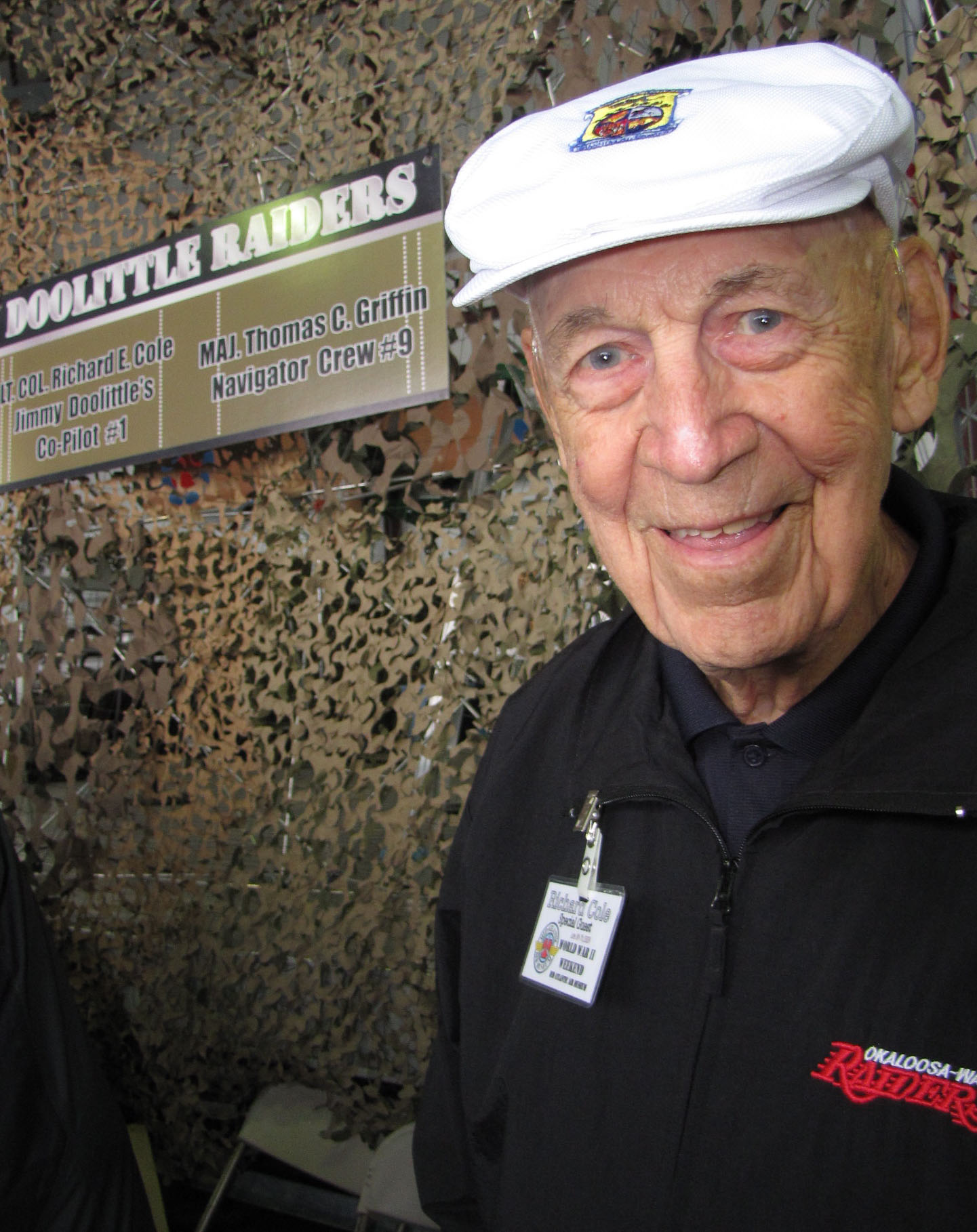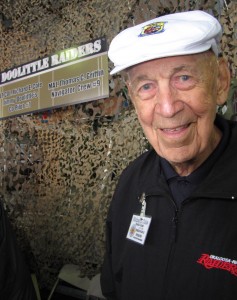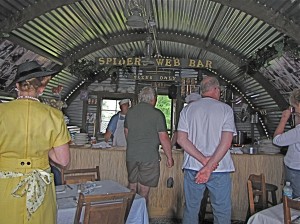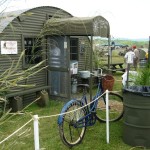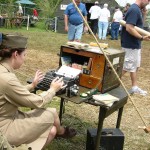By Jack Elliott
World War II was one of the most justifiable as the free world was severely threatened. Those historic years have been recreated annually with an incredible degree of reality thanks to the Mid-Atlantic Air Museum at Carl A. Spaatz Field in Reading, Pa. This marked the 19th year the museum has staged a WWII weekend at the field.
Attending this event is like stepping back in time. There were more than 1,000 re-enactors—men and women dressed in WWII uniforms, some equipped with WWII weapons. Seventy WWII aircraft were on display and performed fly-bys. There were 200 vehicles to see, from Jeeps and tanks to civilian automobiles of the era and even some German military vehicles. There were dozens of tents duplicating various military field facilities like headquarters, communications, radio, press, a hospital tent and more. There was even a reproduction of a French village.
In the evening, Big Band music of the 1930s and 40s entertained the crowd, many wearing clothing from that time.
Walking through the vast encampment with warbirds roaring overhead is an awesome experience, but it is overshadowed by meeting and talking to the actual heroes of the WWII aerial battles.
The highlight of this year’s event was the appearance of Lt. Col. Richard E. Cole, Jimmy Doolittle’s co-pilot on the historic Doolittle Raid on Tokyo just four months after the Pearl Harbor attack. A second Doolittle Raider was there as well—Maj. Thomas C. Griffin, the mission’s navigator who was aboard aircraft No. 9. There are only nine survivors of the 80 crew members who were aboard the 16 B-25 bombers used in the raid.
The museum hangar was cleared out and tables were set so some of the top surviving WWII pilots could sign books they have written or books about them. Cole and Griffin sat side by side signing copies of “The Doolittle Raid” by Col. Carroll V. Glines, who worked with Jimmy Doolittle on his autobiography. Glines wrote four previous books on the Doolittle Raid. Alongside them was Col. Clarence “Bud” Anderson, a Triple Ace signing his book “To Fly and Fight.” Anderson flew 116 combat missions in a P-51 Mustang escorting heavy bombers. He was credited with 16¼ kills (five kills makes a pilot an Ace.) He served two tours of duty and later worked as a test pilot for 25 years.

Lt. Col. Clarence E. “Bud” Anderson, triple ace (16 1/4 kills) displays his book, “To Fly and Fight”.
At age 93, Cole hardly shows his age. He walks with a normal gait and is very relaxed and a great conversationalist. I asked how he came to be Jimmy Doolittle’s co-pilot in the lead aircraft of the historic raid.
“It was not planned,” he explained. “It just happened! We were at Eglin Field in Florida for training. We had to become carrier qualified, and we had instruction in low-level navigation and bombing. Each plane had to take off within 500 feet with a full load of gas and 2,000 pounds of bombs. We were about to go up on a training flight just before leaving for San Francisco to board the carrier, Hornet. I was in the co-pilot seat, but my pilot wasn’t there.”
Doolittle saw the empty seat, climbed aboard and took over. It turned out that the pilot was sick and never made the raid. But Jimmy liked his crew and their teamwork, so he stayed with them. “Airplane numbers hadn’t been assigned yet, but of course we became aircraft No. 1 when they were,” said Cole.
In his autobiography, Doolittle described Cole as “a quietly competent pilot.” He said, “If anything happened to me, I was confident that he would take over the controls of the aircraft and the leadership of the crew.”
The men who participated in the raid were all volunteers. “When we first assembled, Doolittle told us we were going on a dangerous mission and that he wished us all well. He said that if anyone wanted to withdraw from the mission, they could. No one did.”
In spite of the short-field takeoff training they received, doing it from the carrier was a challenge. The sea was rough, which didn’t make it any easier. They were to come within 250 miles of Japan before taking off. But Japanese boats spotted them, so they had to take off 200 miles further out. They were to fly to China after the raid, but now they would have a lot less fuel than planned.
What did he and Doolittle talk about during the four-and-a-half hour flight? “We didn’t talk,” Cole said. “It was quiet. We took turns flying, but we didn’t talk. Each plane had an intercom, but there was no interplane communications. They didn’t fly in formation. Each plane was on its own flying to its own target. We dropped our incendiary bombs and headed for China.”
In addition to having to fly 200 miles further than expected, they ran into storms.
“We had heavy headwinds,” Griffin said, “so it was hard to figure out where we were. We flew at 10,000 feet to stay over the mountains.”
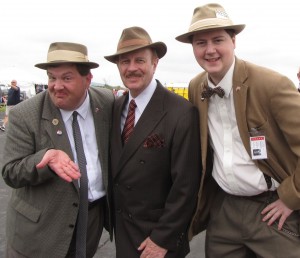
World War II reenactors dressed in 1940s garb. The two men on the left impersonated comedians Abbott and Costello.
Both of their planes flew until they ran out of gas, and then the crews bailed out. Cole’s plane came down on a mountain near the coast. Doolittle landed in a rice paddy. Griffin came down about 70 miles inland. The men landed in the trees.
“I made a hammock out of my parachute and wrapped myself up in it for the night. In the morning, I could see I was about 12 feet up, and I came down gently,” said Cole.
Remarkably, all of the men and both planes landed safely that stormy night. They came down in an area that was occupied by the Japanese, which created something of a problem. They didn’t want to mistake Japanese for Chinese. The Raiders had been told, “The Japanese never smile. The Chinese do.”
In the morning, Cole said he walked and walked until he came across two young Chinese men. He recited the Chinese phrase for, “I am an American.” They didn’t understand him. He met a farmer and repeated the phrase again with no better results. Finally, he met up with some Chinese guerrillas who took him to their shack where Doolittle was waiting. The entire crew was amazingly reunited!
Cole related how the Chinese took them to a river boat that went to Chungking and an American embassy. Later, some 259,000 Chinese were executed for allegedly helping the American pilots.
From Chungking, the Raiders were flown to Calcutta where they rejoined American forces. Cole remained in China for a little more than a year flying bombing and transport missions over The Hump. He returned to the U.S. and volunteered for the aerial invasion of Burma.
About the heroes
Cole was born in Dayton, Ohio, and attended Ohio University. After the war, he settled in Texas and became a citrus farmer.
Every year a group of the Raiders would get together and enjoy fly fishing together in Colorado. “I went for 15 years,” Cole said. “We did all our own cooking. Doolittle was the dish washer.”
Griffin was born in 1916 in Green Bay, Wis. He graduated from the University of Alabama. “I expected to go into law,” he said. He was commissioned in 1939 through the college’s ROTC program. In 1940, he asked to be relieved of active duty in order to enlist as a flying cadet.
After the Tokyo Raid, he became a B-26 navigator in North Africa. On July 4, 1943, just before his 26th birthday, Griffin was shot down over Sicily and captured by the Germans. He was a prisoner of war for 22 months. After being discharged, he became an accountant and now lives in Ohio.
More than 20,000 people attended the WWII weekend. For those who had the opportunity to meet a Doolittle Raider, the memory will only continue to grow in importance.
- Doolittle Raiders Lt. Col Richard E. Cole, left, and Tom Griffin.
- An exterior view of the Spider Web Bar.
- Noted aviation artist Gil Cohen with his painting, “Rosie’s Crew” and a reenactor in full gear.
- A clerk fills out papers on an old manual typewriter.











